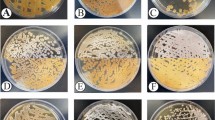Abstract
The ever-increasing broad spectrum of diseases and the urgent need to combat it has become a challenge, opening an exciting avenue in the field of biotechnology and biomedical research to produce a potent drug. Epiphytic Actinobacteria being a prolific producer of a thousand biologically active secondary metabolites play a significant role in the production of various antimicrobial, antiviral, anticancer, probiotics, and other industrially important compounds. Lichens as a symbiotic structure of alga and fungi known as the ecological niche of various kinds of microbes serve as an alternative source for the isolation of such novel Actinobacteria. The study focuses mainly on the collection, pretreatment, and isolation methods of Epiphytic Actinobacteria isolated from lichens, many of which have been successfully isolated and turned into useful drugs and other organic chemicals. With the increasing advancements in science and technology, there would be greater demand in the future for new bioactive compounds synthesized by Actinobacteria from various lichen sources.
Access this chapter
Tax calculation will be finalised at checkout
Purchases are for personal use only
Similar content being viewed by others
References
Ludwig W, Euzéby J, Schumann P, Busse HJ, Trujillo ME, Kämpfer P, Whitman WB (2012) Road map of the phylum Actinobacteria. In: Bergey’s manual® of systematic bacteriology. Springer, New York, NY, pp 1–28
Battistuzzi FU, Hedges SB (2009) A major clade of prokaryotes with ancient adaptations to life on land. Mol Biol Evol 26(2):335–343
Lewin GR, Carlos C, Chevrette MG, Horn HA, McDonald BR, Stankey RJ, Currie CR (2016) Evolution and ecology of Actinobacteria and their bioenergy applications. Annu Rev Microbiol 70:235–254
Das A, Khosla C (2009) Biosynthesis of aromatic polyketides in bacteria. Acc Chem Res 42(5):631–639
Book AJ, Lewin GR, McDonald BR, Takasuka TE, Wendt-Pienkowski E, Doering DT, Currie CR (2016) Evolution of high cellulolytic activity in symbiotic Streptomyces through selection of expanded gene content and coordinated gene expression. PLoS Biol 14(6):e1002475
Coombs JT, Michelsen PP, Franco CM (2004) Evaluation of endophytic actinobacteria as antagonists of Gaeumannomyces graminis var. tritici in wheat. Biol Control 29(3):359–366
Currie CR, Scott JA, Summerbell RC, Malloch D (1999) Fungus-growing ants use antibiotic-producing bacteria to control garden parasites. Nature 398(6729):701–704
Janardhan A, Kumar AP, Viswanath B, Saigopal DVR, Narasimha G (2014) Production of bioactive compounds by actinomycetes and their antioxidant properties. Biotechnol Res Int 2014:217030
Castillo UF, Strobel GA, Ford EJ, Hess WM, Porter H, Jensen JB, Stevens D (2002) Munumbicins, wide-spectrum antibiotics produced by Streptomyces NRRL 30562, endophytic on Kennedia nigriscans. The GenBank accession number for the sequence determined in this work is AY127079. Microbiology 148(9):2675–2685
Ahmadjian V (1993) The lichen symbiosis. Wiley, New York, NY
Suzuki MT, Parrot D, Berg G, Grube M, Tomasi S (2016) Lichens as natural sources of biotechnologically relevant bacteria. Appl Microbiol Biotechnol 100(2):583–595
de la Torre JR, Goebel BM, Friedmann EI, Pace NR (2003) Microbial diversity of cryptoendolithic communities from the McMurdo Dry Valleys, Antarctica. Appl Environ Microbiol 69:3858–3867
Nayaka S (2005) Studying lichens. Sahyadri E-News, Western Ghats Biodiversity Information
Küster E, Williams ST (1964) Production of hydrogen sulfide by streptomycetes and methods for its detection. Appl Microbiol 12(1):46–52
Njenga WP, Mwaura FB, Wagacha JM et al (2017) Methods of isolating Actinomycetes from the soils of Menengai Crater in Kenya. Arch Clin Microbiol 8:3
Waksman SA (1961) The role of antibiotics in nature. Perspect Biol Med 4(3):271–287. https://doi.org/10.1353/pbm.1961.0001
Jiang Y, Li Q, Chen X, Jiang C (2016) Isolation and cultivation methods of actinobacteria. In: Dhanasekaran D, Jiang Y (eds) Actinobacteria–basics and biotechnological applications. InTech, Rijeka, pp 39–57
Gayathri P, Muralikrishnan V (2013) Isolation and characterization of endophytic actinomycetes from mangrove plant for antimicrobial activity. Int J Curr Microbiol App Sci 2(11):78–89
Chaudhary HS, Yadav J, Shrivastava AR, Singh S, Singh AK, Gopalan N (2013) Antibacterial activity of actinomycetes isolated from different soil samples of Sheopur (a city of Central India). J Adv Pharm Technol Res 4(2):118
Nayaka S (2014) Methods and techniques in collection, preservation and identification of lichens. Plant taxonomy and biosystematics: classical and modern methods. New India Publishing Agency, New Delhi, pp 101–105
Sheik GB, Maqbul MS, Gokul Shankar S, Ranjith MS (2017) Isolation and characterization of actinomycetes from soil of Ad-Dawadmi, Saudi Arabia and screening their antibacterial activities. Int J Pharm Pharm Sci 9(10):276–279
Author information
Authors and Affiliations
Editor information
Editors and Affiliations
Rights and permissions
Copyright information
© 2022 The Author(s), under exclusive license to Springer Science+Business Media, LLC, part of Springer Nature
About this protocol
Cite this protocol
Banu, M.S.S., Nargis Begum, T., Vinothini, G., Dhanasekaran, D., Thajuddin, N. (2022). Isolation of Epiphytic Actinobacteria from Lichens. In: Dharumadurai, D. (eds) Methods in Actinobacteriology. Springer Protocols Handbooks. Humana, New York, NY. https://doi.org/10.1007/978-1-0716-1728-1_19
Download citation
DOI: https://doi.org/10.1007/978-1-0716-1728-1_19
Published:
Publisher Name: Humana, New York, NY
Print ISBN: 978-1-0716-1727-4
Online ISBN: 978-1-0716-1728-1
eBook Packages: Springer Protocols




